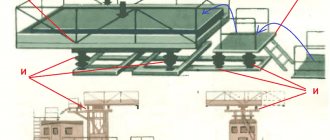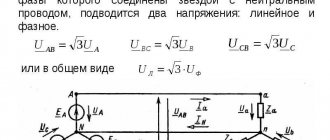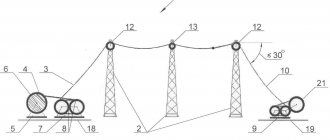What is step voltage
How often do you see current flowing through wires? Everyone knows that current is invisible. To see it means to come face to face with an emergency situation.
For example, when a short circuit occurs in a circuit, an electric arc is formed.
If a bare wire falls to the ground, this reaction will not occur, but there will be voltage around the point where the wire touches. At a walking distance, it poses a great danger.
In this and similar situations: the potential difference between two points of an electric current circuit located at a distance of a step from one another, on which a person is simultaneously standing, is called step voltage or step voltage.
To understand where this tension comes from, let’s look at the reasons.
What is meant by pitch tension?
If we talk about what is meant by step voltage, then we are talking about the voltage near the wire or cable that has fallen to the ground or is located on the working surface. One human step (with a distance of approximately 80 cm) is enough to create a dangerous potential between the points.
The magnitude of this potential depends on the voltage class of the electrical installation and the distance to the fault. The closer a person is to a downed wire, the greater the risk of electric shock. One human step can generate a voltage from tens to several thousand volts.
The definition of step voltage in regulatory documents is as follows:
After storms and hurricanes, trees fall onto overhead lines. As a result, the wires break and the supports break. As a result, the possibility of defeat in the area near the lines is quite high.
Emergencies of this nature are eliminated at the supply substation. Relay protection reacts to damage and turns off the damaged area. But it should be noted that in most cases, after shutdown by the protections, voltage is reapplied to the line. This is necessary if the cause eliminates itself and the line is released from branches or paws of small animals/birds that accidentally blocked the air insulation.
But no one can guarantee the smooth operation of the automation when a wire breaks or sag next to a swaying branch.
When crossing power lines, make sure there are no wires or cables hanging from trees. The current also flows through the trunk, creating the preconditions for danger.
Causes of step voltage
According to the principle of conductivity of electric current, all materials are divided into conductors and dielectrics. For example, the earth is a conductor, especially in wet weather. If, when a power line wire breaks, it touches the ground, then a dangerous zone is formed there, in which step voltage arises.
A similar situation occurs when lightning strikes a lightning rod that is connected to an electrical installation. In this case, contact is formed between the conductive elements of the installation and the ground, on which a live zone is formed.
The reason for the formation of a dangerous step voltage zone can be:
- Accident at an electrical substation;
- Short circuit of overhead lines outdoors or cable lines indoors.
All of the above cases pose a danger to people and animals.
What is the danger?
Imagine the situation: a broken wire lies on the ground and, as it may seem at first glance, does not pose any signs of a threat, but it may be live.
Let me remind you that the earth is a good conductor of electricity. When a person is in close proximity to a wire, he is imperceptibly exposed to step voltage. The danger is that a potential difference forms between the legs.
When exposed to electric current, a person tries to take a wider step, and at this moment the potential difference becomes higher. As a result, involuntary convulsive muscle contractions lead to a person falling to the ground.
When falling, the distance between the points of contact with the ground increases, which in turn poses an increased danger.
When we talk about a broken wire touching the ground with its bare end, we don’t even think about the danger it could pose. The higher the voltage of the damaged line, the more dangerous the area of influence of this voltage.
Entire overhead lines or cable systems do not pose a danger, but in the event of a natural or technical emergency they pose a great threat.
For example, lightning hitting a lightning rod, a power pole, or just a tree causes electric current to spread through the conductors to the ground. This is where a dangerous step voltage zone is formed.
The rule of survival says:
During thunderstorms and lightning, you need to stay away from tall trees, buildings and structures.
In wet weather, generally try not to get close to open (non-insulated) electrical appliances and equipment. Remember, if you stand with one foot on the grounding conductor and the other at a distance of a step from it, then this will not lead to good. And keep in mind that the average step length of a man is 0.81 m.
The human body is included in the electrical circuit as a load, and the harmful effects of electric current on the body occur. But if a person’s shoes are made of non-conductive materials, such as rubber boots, there is less chance of injury.
The risk in this situation may be the presence of alcohol in the blood and the presence of open wounds on the legs. Because this fact affects human conductivity. And since the skin is a protective dielectric, breaking the skin removes your protection.
In addition to conductivity, ambient temperature may be a risk. After all, the higher it is, the more dangerous it is to be in the risk zone.
In all the previously listed cases, step voltage poses a danger to human life, animals and especially children. Therefore, limit your children's play near electrical installations.
Methods of protection, electrical safety
If you see a wire lying on the ground, under no circumstances should you approach it. The dangerous zone can be from 5-8 meters around the point of contact of the wire with the ground and more, depending on the voltage class of the line and the condition of the ground (wet ground increases the space for the spread of electric current).
When lightning strikes a tree, lightning rod or power pole, electric current enters the ground and spreads in the ground in all directions up to several tens of meters. In such places there may be step voltage. The same thing happens near a live electrical wire that has fallen to the ground. Let's imagine that a lightning strike struck a tree near which a person was standing at that time.
The electric current of lightning, falling into the ground and spreading in it, also passes under a person’s feet. If the legs are apart, then the current enters one leg and, passing through the body, goes into the ground through the other. This is step voltage, in this case the person is under step voltage.
To prevent a person from being exposed to current where the step voltage is, it is necessary to place all protective grounding devices where there are no people. In particular, lightning rods in rural areas should be grounded no closer than 4 meters from the walls of houses and must be fenced.
During a thunderstorm, you should stay away from power poles and do not stand near tall trees, especially in open areas. This is also necessary because near any object prominent on the surface of the earth (tree, mast, power line support, lightning rod) during a thunderstorm, conditions are created under which lightning rushes precisely to this object, where step voltage can occur. As a rule, it affects everything within a radius of tens of meters.
If a person is struck by lightning, where the step voltage occurred, the victim must undergo artificial respiration and closed cardiac massage. And immediately take him to a medical facility or call an ambulance.
In the energy sector there is such a term as “Safety” - it appeared for a reason. Each line of this set of safety rules for operating and disabled electrical installations has its own story, which ended in tears. Therefore, you should not neglect these simple tips, so as not to be exposed to electric current completely unexpectedly.
Step Voltage Danger Zone
The current spreading zone can be within a radius of about 10 meters or more from the point where the broken wire touches the ground. The radius of the hazard zone that is energized depends on several factors.
First: distance from the source of danger. The further away, the less danger.
Second: broken wire line voltage: 0.4; 1; 3; 6; 10; 35; 110; 220 kV.
If the humidity of the ground through which the current will flow is higher than normal, then you need to take into account that in the cases listed above, the range of action increases. Based on all the above conditions, the zone located within a radius of 8-10 meters from the source is especially dangerous.
Rules for moving in the step voltage zone
It is necessary to move within the radius of the voltage while observing safety precautions.
You need to move without lifting your feet from the ground in steps no more than the length of your foot. Never touch exposed wires and cables with your hands until you are sure that the voltage has been removed!
Prohibited!
Run or move in a spiral within the range of the step voltage.
According to the rules, the movement of repair personnel within the radius of electric shock must be carried out after calculating the maximum step voltage and its radius.
Step Voltage Calculation
Calculate the voltage value using the formula:
From the formula it can be seen that the step voltage directly depends on the short circuit current, soil resistivity and is inversely proportional to the potential difference between two points of the soil, multiplied by 2π.
By two points we mean the difference in the ratios between the length to the accident site and the sum of the distances from the injury site to the subject and the estimated step length. When calculating, the step of a person or animal is taken to be 0.7-1 meter.
Since the step voltage flows through the ground, and it in turn consists of different layers of soil, to carry out accurate calculations it is necessary to multiply the soil resistance by the appropriate coefficient.
Calculation example.
With a ground fault current of 400 Amperes, a soil resistance of 150 Ohm*m (loam), a distance from a person to the point where the wire touches the ground of 15 meters and a step distance of 0.50 m, we get a voltage of 20.5 Volts.
The circuit current will depend on the network voltage and, accordingly, the higher it is, the greater the step voltage. Hence the recommendation to reduce the distance when walking in the danger zone. But the closer you are to the source of danger, the greater the voltage several times.
At a distance of 10 meters from the source, the step voltage, with the same parameters, will already be 45 Volts, which in turn is unsafe for humans.
Leaving the step voltage zone
When you notice a bare wire touching the ground late, that is, you find yourself in the coverage area, then you need to move in a “goose step”, heading straight from the place where the wire touches in the opposite direction.
Jumping or walking on one leg, as some people advise, is dangerous!
Since when you fall, your whole body will be under the influence of the tension from which you wanted to escape. In this case, damage will be caused to the entire body. Be careful!
How to move and get out of the zone correctly
To avoid becoming a victim of an electric shock near a torn power line wire, you need to know how to move correctly in the step voltage zone. First of all, they leave the threat area, moving away to a non-dangerous distance of at least 8 m. When moving in dangerous areas of current influence, a “goose step” is used.
You might be interested in How to choose a color temperature
Important! Touching objects and people in the area of current flow is prohibited.
Correct movement
To be able to leave the SHN area without being exposed to danger, you must follow the electrical safety rules:
- Move along the area of tension using a goose step.
- During movement, the heel of the walking leg is placed towards the toe of the supporting leg.
- It is prohibited to separate the sole from the soil or other ground covering.
- The scope of steps should be reduced to the maximum extent.
- It is prohibited to move around the place by running or jumping.
- It is forbidden to move towards the lying cable.
- Spiral movement is prohibited.
Additional Information! For safe movement in the safety zone, in particular for freeing a person, it is necessary to use special electrical protective equipment - dielectric boots.
First aid for electric shock
Always think about your own safety!
- First aid must be started immediately. The first step is to free the victim from the effects of electric current.
- Then immediately call an ambulance!
- If there is no breathing or heartbeat, begin artificial respiration and cardiac massage.
- If possible, apply a sterile dressing to the electrical burn site.
- Provide peace to the victim.
The victim, regardless of his health, should be sent to a medical facility.
What should not be done with the victim and why:
- Bury in the ground (breathing will be difficult, which will affect the functioning of the heart)
- Pour water over it (cools the body)
- Contaminate the surface of the burn (tetanus or gangrene begins to develop)
How to free a person
If you were not alone and your companion in front suddenly fell, falling into the zone of spreading step voltage, because the electric current caused an involuntary contraction of the leg muscles, you should not rush towards him. You need to assess the situation and approach him in small steps, wrapping your hands in dry clothes, pulling the victim away from the affected area.
You can also come under step voltage at home by touching a faulty electrical appliance plugged into the network, thus forming an electrical circuit. To avoid such accidents, it is necessary to install an RCD in the apartment panel or organize a grounding system together with a potential equalization system.
What to do if you see a person exposed to electric current in a room? Don’t panic, the first thing you need to do is break the circuit by turning off the switch or circuit breaker. If this is not possible, use a dry wooden object, wrapping your hands in dry clothing, remembering your safety, and try to free the victim with this object by throwing it away or placing it between the person and the source to break the chain. The pictures below show the measures that need to be taken to free the victim, including after a step voltage injury:
It will be interesting➡ What is electromotive force (EMF) and how to calculate it
Step voltage range
After freeing the person, pull him to a safe place, feel the pulse and look at the reaction of the pupils to light. Call an ambulance and begin emergency cardiopulmonary resuscitation, artificial respiration and cardiac massage until the ambulance arrives. If the victim regains consciousness, place him on his side so that a sudden gag reflex does not enter the respiratory tract. You can find out more clear step-by-step actions in our article - how to provide assistance in case of electric shock. Remember that each point in the rules is the life or bitter experience of the victim.










